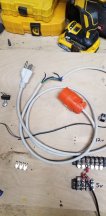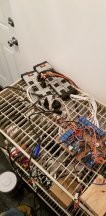Arduino
- Thread starter Turpman
- Start date
spyralout
🌱🌿🌲🔥💨
Totally downLmfao, we should have an adults 6th grade robotics class and we'd all learn some cool stuff.
TerpyTyrone
LED Recruiter
I'm subbed.
I have interest and a electrical background but no time, I shall live vicariously through your Journal until I find 2 of me


I have interest and a electrical background but no time, I shall live vicariously through your Journal until I find 2 of me
SSGrower
Average Grower
To to basic things is not difficult at all, want proof?
Shit may look janky but been controling my lights and environment reliably with it. I got pissed when the 3rd hydrostore timer took a shit on me in a month.
You should see some of the smack talk that happens on the arduino forums, rough gettin taken to schooled by a 10 year old but all for a good cause.
If y'all are serious I'll throw down a parts list and give you my code. I have to do a rewrite so I am gonna be getting a refresh on programming anyway.
@dstroy uses a raspi for most of his stuff and is miles beyond me.
Shit may look janky but been controling my lights and environment reliably with it. I got pissed when the 3rd hydrostore timer took a shit on me in a month.
You should see some of the smack talk that happens on the arduino forums, rough gettin taken to schooled by a 10 year old but all for a good cause.
If y'all are serious I'll throw down a parts list and give you my code. I have to do a rewrite so I am gonna be getting a refresh on programming anyway.
@dstroy uses a raspi for most of his stuff and is miles beyond me.
Last edited by a moderator:
dstroy
Insanely Active Member
Yes, you want to control light intensity with PWM? Many projects do this, and you should start with a breadboard, a couple resistors and LEDs. Then watch some tutorials on "analogwrite". Once you're confident your code works then you can try to apply your analog output to the real circuit you want to controlLol cool ya been looking at both but I'm a little old to learn the raspberry code. Most of my stuff will be on-off.
Are you doing any light ramping? Would be cool to do some far red ramp to bright then ramp back down to the red befor off.
You are not too old to learn. I was in the military for 12 years and started going back to school right when I got out.
Good luck
ChronicWonders
BTM
I feel I’d need to rewire my brain/learn from the basics. Any good places to start/tips?
As a soil grower this is similar to translating mandarin...
As a soil grower this is similar to translating mandarin...
ChronicWonders
BTM
My extent/knowledge with electronics is setting up my cpu and putting batteries in the remotes. Lite-brites?
Ill be starting at ground 0 here.
Ill be starting at ground 0 here.
Gweedo
PICK YOUR OWN
Im very interested in this, like how much to build all of it, and how well has it been working for you, environment automation is the only way my ass is gonna get some repeatable environmental patterns lol im all over the mapTo to basic things is not difficult at all, want proof?View attachment 31750
Shit may look janky but been controling my lights and environment reliably with it. I got pissed when the 3rd hydrostore timer took a shit on me in a month.
You should see some of the smack talk that happens on the arduino forums, rough gettin taken to schooled by a 10 year old but all for a good cause.
If y'all are serious I'll throw down a parts list and give you my code. I have to do a rewrite so I am gonna be getting a refresh on programming anyway.
@dstroy uses a raspi for most of his stuff and is miles beyond me.
dstroy
Insanely Active Member
I feel I’d need to rewire my brain/learn from the basics. Any good places to start/tips?
As a soil grower this is similar to translating mandarin...
To teach yourself how to think like a programmer. This is probably one of the fastest ways you can just start learning to code from your browser.
It's targeted at kids and people like you who want to learn how programming works. Most times, language-to-language there are quite a few similarities and you should be able to apply things you learn how to do on scratch to c++.
SSGrower
Average Grower
Cost for what is on that board is about 60 bucks, 15 for each of the arduino unos, 10 bucks for the 8 relay board, 5 for the 4 relay board, 5 for each of the battery backup clocks, 5 bucks for each temp and humidity sensor. So far as reliability that all depends on code and construction, parts are basically same quality as what you see on products like inkbird.Im very interested in this, like how much to build all of it, and how well has it been working for you, environment automation is the only way my ass is gonna get some repeatable environmental patterns lol im all over the map
If you are willing to learn programming you could easily do what I am doing with one arduino, I am using 2 because I have not taken the time to learn i2c protocol, or shift registers which would allow me connect all relays and sensors to one arduino, I basically ran out of digital ports, you could also get an arduino mega.
Adafruit produces these components and has tutorials on how to apply them. Beyond taking basic in highschool almost 30 years ago I got no programming experience, the key is to train your brain to think like a computer, there are no maybees just yes and no. You ask if a particular parameter (environmental or otherwise) is true or false then take action.
SSGrower
Average Grower
This will give you an idea of the reliability, since I put it together 3 maybe 4 years ago I havent bought anything for it. So no idea on any current sales but there is a kit called the garduino has moisture sensors and solenoid valves. If you look at how dstroy manages his resivoir with it shit he has pH and tds sensors n shit like that for true set and forget, personally I'd look for the @dstroy garden spring 2020?
Me? This is my version of a smart extension cord.

Me? This is my version of a smart extension cord.

dstroy
Insanely Active Member
Yeah, I operate on two principles:
1) I am very busy
2) Everything can be automated (except training, pruning, cleaning, inspections* (unless you're using AI))
I start by making a heirarchical bubble flow chart of things I want some imaginary equipment to do, eventually you'll break big things down into steps that need to be performed (an algorithm) in order to accomplish some task.
It's much easier to make one small thing work at a time individually and then putting those pieces together.
Planning is very important, I just now started putting things together for my new controller that I started designing almost immediately after the first one was done. I just kept adding features to solve system specific problems for me and whatnot until I ended up where I am now.
There's a lot of data in these plants that's there for us to grab, just gotta connect it up somehow, and then make sense out of it.
1) I am very busy
2) Everything can be automated (except training, pruning, cleaning, inspections* (unless you're using AI))
I start by making a heirarchical bubble flow chart of things I want some imaginary equipment to do, eventually you'll break big things down into steps that need to be performed (an algorithm) in order to accomplish some task.
It's much easier to make one small thing work at a time individually and then putting those pieces together.
Planning is very important, I just now started putting things together for my new controller that I started designing almost immediately after the first one was done. I just kept adding features to solve system specific problems for me and whatnot until I ended up where I am now.
There's a lot of data in these plants that's there for us to grab, just gotta connect it up somehow, and then make sense out of it.

